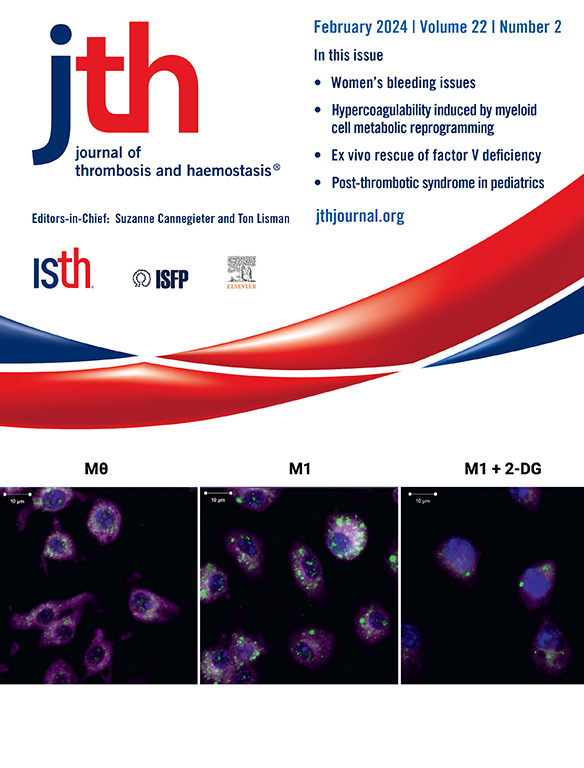The individual fibrinolytic capacity predicts the efficacy of ultrasound-assisted catheter-directed thrombolysis in patients with acute pulmonary embolism
IF 5.5
2区 医学
Q1 HEMATOLOGY
引用次数: 0
Abstract
Background
Ultrasound-assisted catheter-directed thrombolysis (USAT) is nowadays available as an alternative reperfusion approach for acute pulmonary embolism (PE). The lytic agent recombinant tissue-type plasminogen activator (rt-PA) activates the effector protease plasmin to induce fibrinolysis.
Objectives
The aim of this study was to identify predictive markers for the efficacy of USAT in patients with acute PE.
Methods
In a single-center cohort study of USAT for intermediate-high or high-risk PE, pulmonary-arterial hemodynamic measurements were performed, and plasma samples were obtained from 35 patients before treatment start, at 6 hours (during infusion of rt-PA), and at 24 hours after treatment start (postlysis). The hemostatic properties were evaluated with thromboelastometry, and fibrinolytic markers and the ex vivo capacity of rt-PA–spiked plasma to generate the plasmin-antiplasmin complex were assessed.
Results
Patients presented with an elevated mean pulmonary artery pressure (32.9 ± 7.6 mm Hg), with an average postlysis reduction of 9.4 ± 8.3 mm Hg, yet the treatment response varied markedly across individuals. The endogenous fibrinolytic capacity, as represented by the plasmin-antiplasmin complex and D-dimer, as well as consumption of the endogenous fibrinolysis inhibitor α2-antiplasmin at 6 hours, predicted the individual treatment efficacy, indicated by the reduction in mean pulmonary artery pressure (all P < .05). Furthermore, ex vivo assessment of the fibrinolytic potential before the start of USAT also predicted efficacy. Both maximum clot lysis INTEM and the novel parameter fibrin-sensitivity ratio were identified as predictors of USAT responsiveness (both P < .05).
Conclusion
Markers of fibrinolysis may be harnessed to predict treatment responsiveness to USAT in patients with acute PE.
个体纤溶能力预测超声辅助导管溶栓对急性肺栓塞患者的疗效。
背景:超声辅助导管定向溶栓(USAT)目前可作为急性肺栓塞(PE)的另一种再灌注方法。重组组织型纤溶酶原激活剂(rt-PA)激活效应蛋白酶纤溶酶,诱导纤溶。本研究的目的是确定USAT对急性肺心病患者疗效的预测指标。患者/方法:在一项USAT治疗中高或高危PE的单中心队列研究中,对35名患者进行了肺动脉血流动力学测量,并在治疗开始前、6小时(注射rt-PA期间)和治疗开始后24小时(溶栓后)采集了血浆样本。止血性能通过血栓弹性测量、纤溶标志物评估和rt- pa加标血浆产生纤溶蛋白-抗纤溶蛋白复合物的体外能力来评估。结果:患者表现为平均肺动脉压升高(PAPm;32.9±7.6 mmHg),溶解后平均减少9.4±8.3 mmHg,但治疗效果在个体之间差异显著。内源性纤维蛋白溶解能力,以plap复合物和d -二聚体水平为代表,以及内源性纤维蛋白溶解抑制剂α2-抗纤溶酶在6小时的消耗预测个体治疗效果,通过PAPm的降低来表明(所有结论:纤维蛋白溶解标志物可以用来预测急性PE患者对USAT的治疗反应性。
本文章由计算机程序翻译,如有差异,请以英文原文为准。
求助全文
约1分钟内获得全文
求助全文
来源期刊
CiteScore
24.30
自引率
3.80%
发文量
321
审稿时长
1 months
期刊介绍:
The Journal of Thrombosis and Haemostasis (JTH) serves as the official journal of the International Society on Thrombosis and Haemostasis. It is dedicated to advancing science related to thrombosis, bleeding disorders, and vascular biology through the dissemination and exchange of information and ideas within the global research community.
Types of Publications:
The journal publishes a variety of content, including:
Original research reports
State-of-the-art reviews
Brief reports
Case reports
Invited commentaries on publications in the Journal
Forum articles
Correspondence
Announcements
Scope of Contributions:
Editors invite contributions from both fundamental and clinical domains. These include:
Basic manuscripts on blood coagulation and fibrinolysis
Studies on proteins and reactions related to thrombosis and haemostasis
Research on blood platelets and their interactions with other biological systems, such as the vessel wall, blood cells, and invading organisms
Clinical manuscripts covering various topics including venous thrombosis, arterial disease, hemophilia, bleeding disorders, and platelet diseases
Clinical manuscripts may encompass etiology, diagnostics, prognosis, prevention, and treatment strategies.

 求助内容:
求助内容: 应助结果提醒方式:
应助结果提醒方式:


